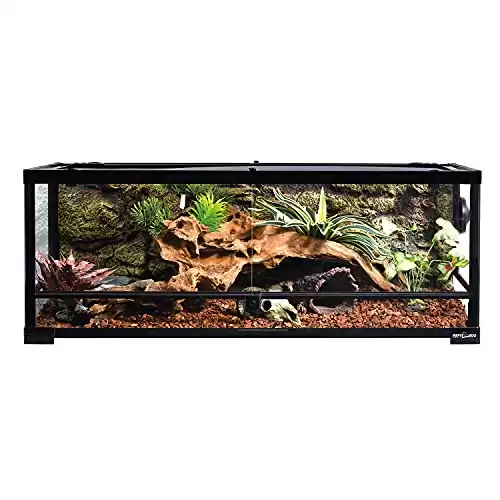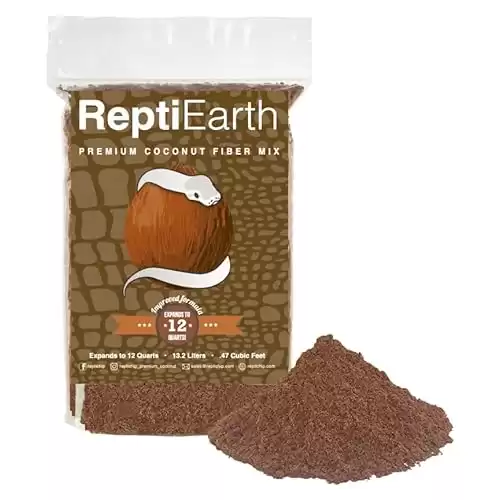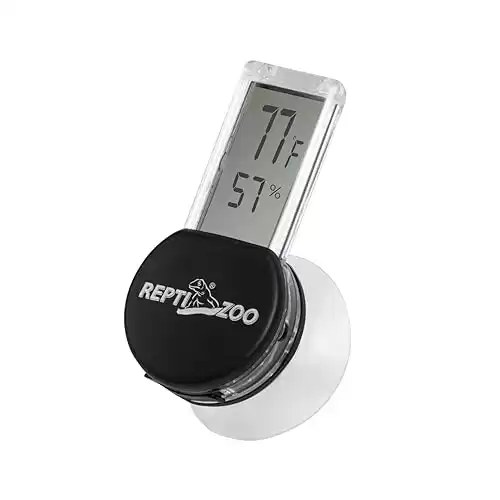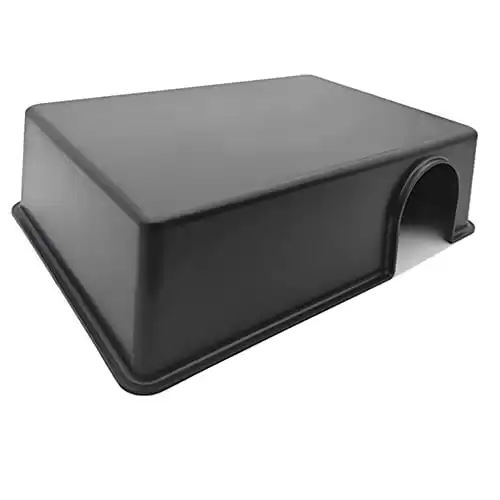
The essential guide to the perfect ball python setup
Ball pythons (also known as Royal pythons) are one of the most popular snakes to own. This is because ball python care is relatively simple and inexpensive even for beginner reptile hobbyists.
In this guide, we explore the perfect ball python setup for your home and how to take care of your python.
Ball Python Size
Ball pythons start off relatively small as hatchlings at about 10 inches, but do not be fooled; they grow rapidly and can reach six feet in length and weigh six to seven pounds upon reaching adulthood!
As babies, they can thrive in a 20-to-30-gallon tank, but once they reach their full size, they need at least 50 gallons to feel comfortable in captivity.
Below is a handy size chart to give you an idea of what to expect from your ball python’s growth rate and how much they should weigh at each stage of their life.
Read our guide on how big ball pythons get, for a more in-depth look at their growth rate.
Ball Python Appearance
Ball pythons’ heads have the typical A-shape common amongst species in the python family. This, along with their slightly upturned snouts and large eyes, gives them an adorable “puppy dog” look. They have thick, robust bodies that end in blunt tails for males and taper to a point for females.
Their natural coloring is dark brown with black markings. However, there are many stunning python morphs that come with unique colorations and patterns.
Some of the more popular morphs have unusual traits like bright yellow coloration, lavender patterning, and even partial albinism known as “pied” or “piebald.”
Ball Python Personality and Temperament
Ball pythons have adorable, puppy-like faces, and they even have the personality to match! They are shy by nature and prefer to go on the defensive instead of attacking their handlers. Ball pythons get their name from their tendency to curl into a ball when scared or stressed.
Though they aren’t the most outgoing species of snake, ball pythons are very docile and excellent pets for reptile lovers who are new to caring for and handling snakes. They are not prone to biting unless they are hurt or feel very vulnerable.
Curiosity is one of the ball python’s most prominent traits. Despite their mild-mannered temperaments, they are surprisingly intelligent and love to explore their enclosures and especially enjoy having plenty of hides, branches, and rocks to interact with for enrichment.
Once you understand the basics of ball python care and how to set up a ball python tank, owning and maintaining a ball python is actually pretty simple.
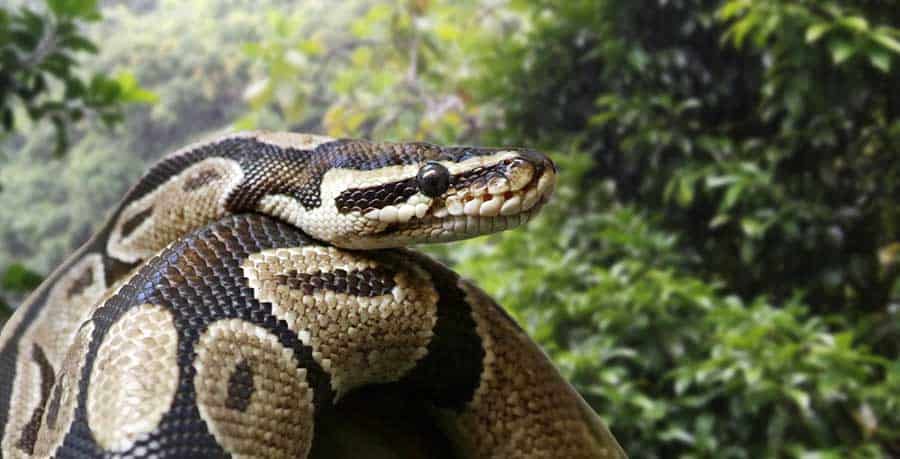
Ball Python Lifespan
Ball pythons are very long-lived snakes! They have an average lifespan of 30 to 40 years in captivity with proper care, a nutritious diet, and an adequately-sized enclosure.
This means the baby ball python you get when you finish highschool could potentially live long enough to meet your children and even your grandchildren!
Check out our in-depth article on how long ball pythons live and what sort of factors can increase or decrease their lifespan.
Let’s look at how to properly care for ball pythons and set up your ball python habitat so your scaly friend can live a happy, healthy life with you for years to come.
Equipment You Need for Ball Python Keeping
There are certain pieces of equipment that you need for a proper ball python setup, these include:
- A 40-gallon tank minimum for adult ball pythons
- Heat mat (or alternatively a heat pad, heat tape or radiant heat panel)
- Heat lamp or a ceramic heat emitter
- Plug-in lamp dimmer (not essential but can be useful)
- Thermometer or humidity gauge (or combined
thermometer and hygrometer) - Artificial foliage, branches, logs, stones etc for enrichment
- Substrate (paper towels, reptile carpet…etc.)
- Hide Boxes (a moist hide box and a normal hide box)
- Feeding tongs
- Misting bottle or automatic misting system
- Large water dish
- Large food dish
- Cleaning supplies
How to Care for a Ball Python: Enclosure Setup
Enclosure Size
Ball pythons are very large, active, and curious snakes, so they need large and well-decorated enclosures to feel comfortable and happy in captivity.
This table below details the absolute minimum size a ball python
Ball pythons are terrestrial snakes, so they mostly explore the floor of their enclosures and only climb occasionally. Therefore, they should be housed in horizontal tanks that are long and wide rather than tall. Check out our roundup of great enclosures for ball pythons.
Your snake should be able to stretch out along the length of their enclosure completely. In addition to them having enough space to move around, they need to be able to get from one side of the enclosure to the other without being seen. Remember, ball pythons are very shy and in their native habitat they spend a lot of time underground, so you need to make sure they have plenty of privacy and clutter in their enclosures.
This is also very important because, in addition to being very shy and private creatures, ball pythons are also nocturnal animals that must feel secure in their environment so they don’t become stressed.
It’s up to you what kind of enclosure you go for – glass enclosures are great for visibility but remember that you’ll need to add plenty of places for your python to hide.
Alternatively you can get wooden vivariums or PVC enclosures which hold the heat better making it easier to maintain ideal temperatures and humid conditions.
Substrate
Substrate is essentially the material you’ll use to cover the floor of your ball python’s enclosure. The substrate you choose will ideally provide a comfortable surface for your pet to move around on and burrow in if desired.
In addition to being comfortable, the ideal substrates for ball pythons hold humidity well, can deal with the weight of an adult ball python without becoming compacted, and can absorb and contain their messes efficiently.
There are many types of ball python substrate on the market, but some of the best candidates include:
- Bioactive substrate (also known as bioactive soil),
- Cypress mulch (also known as forest floor substrate),
- Coconut husk/coir/fiber,
- Orchid bark (also known as Repta-Bark),
- Kraft paper or newspaper
For a detailed product review of suitable substrates, check out our guide on the best bedding for ball pythons.
Temperature
Like many reptiles, ball pythons like it hot! They should have a heat source to create a basking area as well as an under tank heating pad to help create a stable, gradual temperature gradient in their enclosure.
You need to create a thermal gradient with the enclosure increasing steadily from the cool side of the enclosure (which should not drop below 75°F) to the warm side of the enclosure sitting at around 85°F.
In addition to the heat mat or heat pad, your ball python needs a basking spot at the far end of the warm side of their enclosure that constantly sits at around 90°F. The basking spot can be created by a
It’s a good idea to have a digital
Humidity
Ball pythons require a fairly high humidity level at 50% to 60%. They need this level of average humidity to stay properly hydrated and to shed properly.
To maintain the right humid conditions in your snake’s enclosure, you can either manually mist the inside of the tank, its substrate, and other surfaces every day with a simple spray bottle or install an automatic misting system.
The humidity needs to be monitored constantly with a humidity gauge. Alternatively, you can install a combined
Hiding Spots
As we’ve mentioned hides are an essential part of a good ball python setup. It’s really important that you have hiding spots in your ball python enclosure so they can sleep, rest and get the privacy they need.
As a minimum you should have a cool hide in the colder end of the enclosure and a warm hide near the basking end, but you can also add more hides if there’s space in the enclosure.
The hides need to be dark and cozy, you can also add a moss like sphagnum moss to create a humid hide which supports the shedding process.
UVB Lighting and Photocycles
Ball pythons do not need special UVB lighting because they are nocturnal or crepuscular (active during dawn and dusk) snakes. The ambient light entering their enclosure will provide all the light they need to move around their enclosure.
They do, however, need a proper photocycle each day. This simply means they need to have a period of light and a period of dark, each lasting about 12 hours each day, in order to be healthy. This means if your basking spot or heat source is a light, it must be turned off at night so as to not interrupt their nocturnal behavior.
Ball Python Feeding Guide
Ball pythons are notoriously finicky eaters. They can refuse food for many different reasons, from stress to incorrect temperature and/or humidity settings to simply disliking the taste of certain kinds of prey, so it can sometimes be difficult to get them to eat.
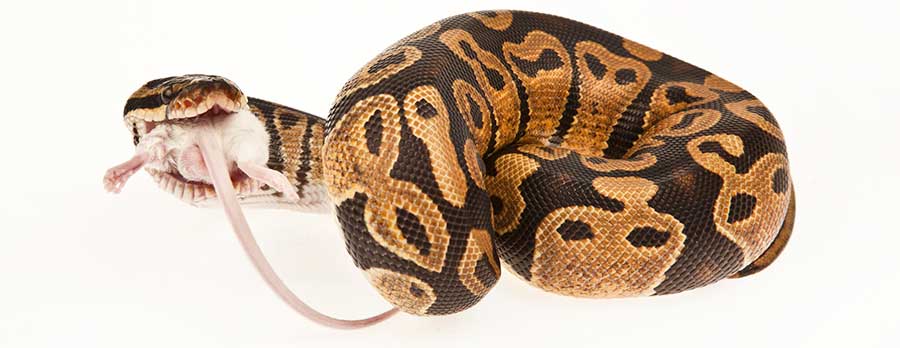
For an in-depth look at what finicky eaters ball pythons are, check out our article on how long ball pythons can go without food!
Below, we’ll go over what ball pythons eat and how to feed them, as well as how much water they need to stay hydrated.
Ball Python Dietary Requirements
Most ball pythons love eating mice and rats. Depending on how large your snake is and their personal preferences, they may prefer eating mice to rats or vice versa.
You can feed a ball python frozen (mostly thawed before eating) mice or rats. These are readily available from pet shops or you can order them in bulk online.
While ball pythons would ideally eat live prey, it’s best to avoid offering live animals to them in captivity. The process of hunting can be stressful for pythons and cause injuries to your snake while their prey struggles to escape. Many reptile owners have reported incidents of their snakes sustaining painful bites and scratches while attempting to take down live prey — some pythons have even lost their eyes to such injuries, so stick to dead prey.
Sizing your ball python’s food correctly is also very important. If the prey item is too large, then they can either choke, become impacted, or refuse the food entirely. If it is too small, then your snake is not going to get a proper meal and may even be bored or disinterested in their food.
Any prey items you offer to your snake should be the roughly size of your ball python’s head.
Hatchling and juvenile snakes should be fed one appropriately sized prey item once every seven days. Adults should be fed one appropriately sized prey item once every 10 to 14 days. However, it is also normal for ball pythons to occasionally refuse food for various reasons for several weeks at a time.
It is essential to monitor your ball python’s eating habits carefully and keep track of their weight. This is because ball pythons are prone to overeating and obesity. Obesity is deadly in snakes and can lead to organ failure.
Water
Ball pythons need to stay well hydrated, and they especially love a good soak. They need access to a large water dish in their enclosure. The heavy
Their water should be refreshed daily, sometimes more than once per day, as they contaminate it every time they put their bodies in the dish. It is common for ball pythons to defecate in their water dishes since the warm water stimulates their bowels.
Tap water is generally fine to use (depending on where you live) but many python owners prefer to use purified water.
The water dish in your python’s tank should meet the below requirements (too much water can affect the humidity in the enclosure):
- Regularly refreshed clean water (about a litre of water is usually enough for an adult snake)
- Non-porous (porous materials can be hard to clean and keep hygienic)
- Large enough water dish for your ball python’s body to fit in at once
- Heavy-bottomed so that it cannot tip over
- Shallow enough that your ball python can get out of it and is not at risk of drowning.
How to Handle a Ball Python
Ball pythons are excellent snakes for handling and socialization. This is because they are very docile and not prone to biting and are small enough to handle with ease.
Check out our guide on ball python bites to prevent any mishaps while handling your snake and learn what to do if you happen to get bitten.
Always remember to pick up your snake with both hands and support their bodies at all times. Ball pythons have heavy bodies, and dropping them can cause serious injuries.
It is essential to wash your hands and wear clean clothes when you are handling your ball python. Snake skin is very susceptible to bacterial and parasitic infections. Cross-contamination is very common if you have multiple reptiles and do not sanitize your hands between handling them.
Common Ball Python Health Problems
Ball pythons, like any other reptile, can suffer from certain health problems – the good news is a lot of these health issues are totally avoidable with proper husbandry and the correct ball python setup.
Below are some of the most common medical conditions. If you think your snake is suffering from any of them then you need to review your ball python cage setup asap.
Obesity
Obesity is a big problem in ball pythons because despite being finicky eaters, when they choose to eat they often eat way too much. Pythons with obesity can suffer from heart disease and fatty livers.
Beginner owners also tend to overfeed their ball pythons when they are in an eating phase because they are worried they’re not eating enough. In reality, it is normal for ball pythons to occasionally refuse to eat for days or even weeks at a time.
Respiratory Infections
If your ball python has a respiratory infection, you will notice it making gurgling or bubbling sounds when they breathe. They may even blow mucus bubbles from their mouths or noses. The most common culprit is incorrect humidity settings.
Scale and Mouth Rot
Due to their high humidity levels, ball pythons are at an increased risk of scale and mouth rot. Scale and mouth rot is a general name for scales or skin issues such as blisters and abscesses.
This needs urgent vet attention because your snake will need antibiotics and potentially even additional fluids if they’re having trouble eating and drinking.
Parasites
Parasites are a constant battle for reptile owners in general. The most common issue for snakes as far as external parasites are mites. Mites often live in dirty or improperly sanitized substrate and burrow under your snake’s scales and into their eyelids and mouths to suck their blood. They carry their own parasites and make snakes very sick very quickly.
You’ll need to sanitize the enclosure and soak your snake if they have mites and put them in a quarantine enclosure far away from any other reptiles in your home.
FAQs About Ball Pythons
The name “ball python” comes from the snake’s main defensive behavior. When a ball python feels threatened, they roll themselves into a ball and bury their heads underneath their coils. While most snakes try to make themselves look larger to intimidate predators, the mild-mannered ball python avoids confrontation altogether!
They are also known as royal pythons, as many African rulers are believed to have worn live pythons as part of their jewelry in the past. Knowing how docile these snakes are, it’s actually a pretty believable story!
Ball pythons come from tropical regions in Central and Western African countries such as Mali, Ghana, the Congo, the Democratic Republic of the Congo, and Sierra Leone. They are very shy terrestrial snakes. They live in very hot and humid habitats where they have plenty of plant cover to hide in.
Slithering Off…
Ball python care is relatively simple once you have an enclosure set up and running. While the initial investment for any reptile is costly, ball pythons are fairly inexpensive to care for long-term. They make excellent pets for both first-time snake owners and the most experienced herp enthusiasts alike.
Always set up your enclosure a week before you bring your ball python home. This will allow you to do a “test run” of your enclosure setup to make sure everything is running properly and that the glass tank has the correct temperature and humidity settings.
Good luck on your journey with your new pet snake.

